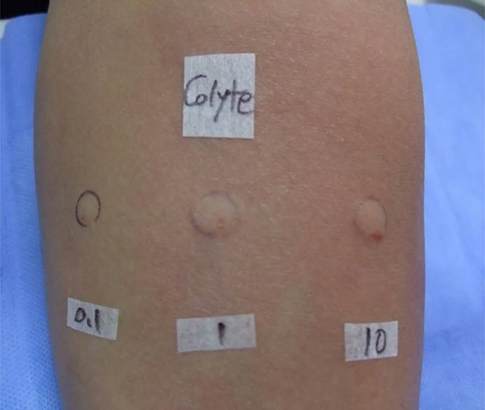J Korean Med Sci.
2016 Oct;31(10):1662-1663. 10.3346/jkms.2016.31.10.1662.
Anaphylaxis to Polyethylene Glycol (Colyte®) in a Patient with Diverticulitis
- Affiliations
-
- 1Department of Allergy and Clinical Immunology, Ajou University School of Medicine, Suwon, Korea. drsys93@naver.com
- KMID: 2468260
- DOI: http://doi.org/10.3346/jkms.2016.31.10.1662
Abstract
- Polyethylene glycols (PEGs) are believed to be chemically inert agents, but larger PEG polymers could have immunogenicity. A 39-year-old man was referred to emergency room for loss of consciousness and dyspnea after taking of PEG-3350 (Colyte®). In laboratory findings, the initial serum tryptase level was increased to 91.9 mg/L (normal range: 0.00-11.40 mg/L) without any other laboratory abnormalities. The intradermal test with 10 mg/mL Colyte® showed a 5 × 5 mm wheal, but basophil activation and histamine releasability tests were negative. PEG-3350 is widely used as an osmotic laxative due to its lack of absorption from the gastrointestinal tract. However, the loss of mucosal integrity at gastrointestinal membrane such as diverticulitis may be a predisposing factor for anaphylaxis to Colyte®. We report a case of anaphylaxis induced by the ingestion of PEG-3350 in a patient with diverticulitis which might be a risk factor of anaphylaxis.
MeSH Terms
Figure
Cited by 1 articles
-
Anaphylaxis due to polyethylene glycol: A case report
Tae-Se Kim, Dong-Chull Choi, Byung-Jae Lee
Allergy Asthma Respir Dis. 2018;6(5):274-276. doi: 10.4168/aard.2018.6.5.274.
Reference
-
1. Knop K, Hoogenboom R, Fischer D, Schubert US. Poly(ethylene glycol) in drug delivery: pros and cons as well as potential alternatives. Angew Chem Int Ed Engl. 2010; 49:6288–6308.2. Lee SH, Cha JM, Lee JI, Joo KR, Shin HP, Baek IH, Jeon JW, Lim JU, Lee JL, Lee HM, et al. Anaphylactic shock caused by ingestion of polyethylene glycol. Intest Res. 2015; 13:90–94.3. Wenande EC, Skov PS, Mosbech H, Poulsen LK, Garvey LH. Inhibition of polyethylene glycol-induced histamine release by monomeric ethylene and diethylene glycol: a case of probable polyethylene glycol allergy. J Allergy Clin Immunol. 2013; 131:1425–1427.4. Chanan-Khan A, Szebeni J, Savay S, Liebes L, Rafique NM, Alving CR, Muggia FM. Complement activation following first exposure to pegylated liposomal doxorubicin (Doxil): possible role in hypersensitivity reactions. Ann Oncol. 2003; 14:1430–1437.5. Almer S, Franzén L, Olaison G, Smedh K, Ström M. Increased absorption of polyethylene glycol 600 deposited in the colon in active ulcerative colitis. Gut. 1993; 34:509–513.6. Shah S, Prematta T, Adkinson NF, Ishmael FT. Hypersensitivity to polyethylene glycols. J Clin Pharmacol. 2013; 53:352–355.7. Stollman N, Manten HD. Angioedema from oral polyethylene glycol electrolyte lavage solution. Gastrointest Endosc. 1996; 44:209–210.8. Schuman E, Balsam PE. Probable anaphylactic reaction to polyethylene glycol electrolyte lavage solution. Gastrointest Endosc. 1991; 37:411.
- Full Text Links
- Actions
-
Cited
- CITED
-
- Close
- Share
- Similar articles
-
- Anaphylaxis due to polyethylene glycol: A case report
- A Randomized Prospective Trial Comparing a New Polyethylene Glycol Based Lavage Solution with the Standard Polyethylene Glycol Solution in the Preparation of Patients Undergoing Colonoscopy (Clinical trial of new PEG solution in bowel preparation)
- Leukocytoclastic Vasulitis Induced by Methoxy Polyethylene Glycol-Epoetin Beta
- The isolation and preservation of nuclei using polyethylene glycol, concanavalin A, and phytohemagglutinin
- Successful mRNA COVID-19 Vaccination and Colonoscopy After Oral Desensitization in a Patient With Polyethylene Glycol Allergy


